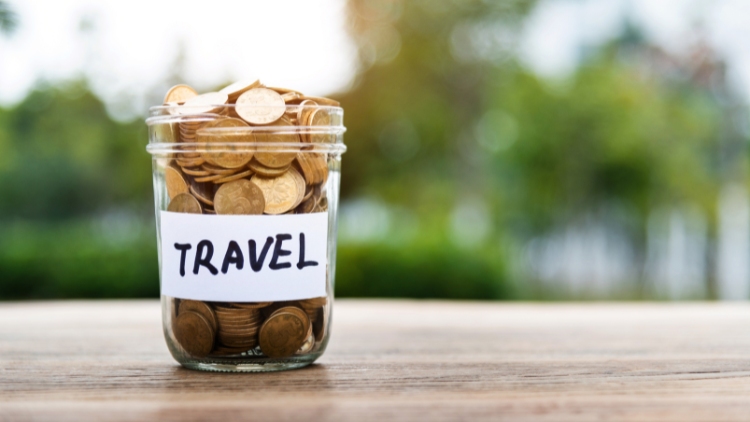
Everyone has to save money for travel. I have been doing so since I took my first trip at 15. Working at a deli, I saved enough to buy a bike and take a month-long cycling tour in England and Wales. Needless to say, saving money for travel became a habit for me.
But, I understand, for some it is a daunting task. After all, it sounds an awful lot like depriving yourself of the joys of life at home.
That needn't be the case. As with many of life's challenges, pick it apart and the path to success will be revealed. Even if the ability to save was not bred in your bones, it can be learned.
And, while you're saving for travel, you can enjoy the period of deferred gratification with trip planning, exploring the tastes of your destination at home, and joining groups to learn a bit of the language.
Below you'll find my step-by-step plan to save money for the travel of your dreams. Even if you don't yet know where you want to travel at this moment, you can be pretty sure that the impulse to travel will surface again soon. Below are my seven steps to save money for travel.

Seven Steps to Save Money for Travel
Everyone is different. What one person gives up to save will be different than another. So, I'm not going to tell you to take shorter showers or stop buying lattes. The specifics of how you save are up to you.
But in another way we are all similar. We tend to spend as much money as we have, making the process of saving similar whether you earn $30,000 or $300,000 a year.
The advice below is more about creating a mindset for saving that suits your lifestyle rather than telling you to clip coupons and look for deals.
A successful savings plan is one that you can stick to–at least most of the time. Follow the steps below and decide for yourself how to save for travel.
1. Know what you currently spend.
You can't save without knowing what you spend. A couple of years ago I was on a tight budget so I tracked and categorized every expense I had for a few months and discovered that every month, for some reason or another, I had about $800 in surprise expenses. Yikes! No wonder I couldn't save–I was being blindsided all the time.
To save money for travel, start by tracking every cent you spend. Categorize those expenses and include a category for the unpredictable.
When you see where you spend you will be able to see where you can save.
2. Set your travel savings goal.
Research the trip you want to take. Get a sense of what it will cost, then round up the number. There are two reasons for rounding up: one is so that you have a nice simple figure in mind as your goal, the second is so you have some space in your travel budget for it to stretch, as it will almost inevitably do. The bigger the actual cost of your trip the bigger the round-up. For example, $8,750 doesn't become $9,000, but rather, $10,000. Read: How to Plan Your Solo Travel Budget – On Any Budget.
3. Create your savings plan.
Since you have tracked your expenses you have the right information with which to set a budget. And because you have a wonderful goal in mind you're motivated. Now you can set a realistic budget.
To start, allocate all your income in one way or another, whether it's to an expense or savings. Then, calculate and project how your savings will add up month over month.
Will your projected savings reach your financial goal in the time you want? If not, either review your budget and decide where to cut or modify your trip plans to align better with your financial situation.
A budget will definitely help you save money for travel. There are many free budget templates on the internet. A quick Google search will yield lots of options.
Tip: The first place to look for savings is your credit card bill. If you are missing payment deadlines, you are incurring interest charges. Pay off your credit card every month, on time. If that's not possible, be as aggressive as possible to get rid of the debt.
4. Create a dedicated travel savings account and watch your savings grow.
Having a separate savings account specifically for travel lets you see your progress towards your travel savings goals. Setting up an automatic withdrawal from your regular account to your travel account ensures that you save to it regularly. $20 a week is over $1,000 a year. $100 per biweekly paycheck is $2,600 a year. Direct funds into this account on a regular basis and give it a bonus deposit when you can.
It's a good idea to use a bank with low fees to save a bit more every month. There are also free credit cards that offer cash back on purchases. You can usually direct the cash-back to a specific account, like your travel savings account.

4. Imagine living your dream trip every day.
It's easier to save money for travel when your travel goal is constantly in front of you. Follow hashtags for your destination on social media. Put images on your fridge and set them as your screensaver. Keep your motivation high by having your trip all around you and by telling people about it.
Declaring your big goal to friends will help you achieve it. Bringing your travel dreams into the light will make them more real, make you feel more accountable and more driven to success.
Tip: Don't carry large balances of points and miles for travel that is not yet planned. Use points as soon as possible. Read Why points and miles are a bad long-term investment.
5. Find joy in minimalism.
The minimalism trend is about having what you need and no more. It's about simplicity and feeling the freedom and elegance of less rather than the weight of more. This also means clearing out what you have but don't need, which can result in money in your pocket if you sell it. It's also about buying less. Before making any purchase, give it serious consideration. How much do you need it? Could you borrow or rent it instead? How much will it contribute to your happiness? Spend wisely. You can only spend a dollar once.
6. Know your spending weakness.
So much in life is about understanding yourself. The same applies when you want to save money for travel. It's important to know what kind of spending makes you go off the wagon. Some of us spend more if we have cash than if we use credit cards. Some are the opposite. Others whip out the debit card without thinking. Know what form of money you are more likely to spend frivolously and don't carry it.
7. Make saving for travel a habit.
How you save money will depend on your lifestyle, but make it a habit and a daily practice. How much you save daily will depend on your income and how you spend. Find ways to cut back $5 a day to contribute $25 per work week over and above what you already plan to save based on your budget. If you buy lunch and take taxis every day, $40 a day is a possibility for you. That's $800 a month!

There you go, my path to saving money for travel. I hope you can adapt it to make it yours.
While you're waiting for your money to grow, remember there are ways to embrace the spirit of travel without leaving home. Here are 17 Ways to Feed Your Wanderlust When You Can’t Travel.
